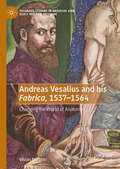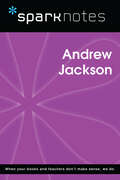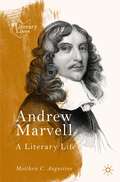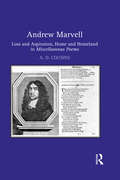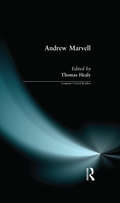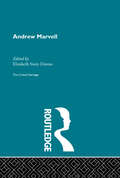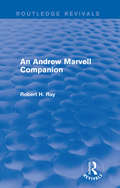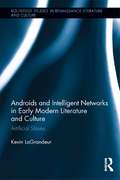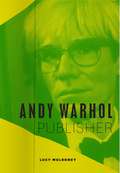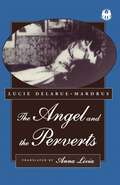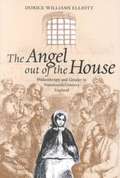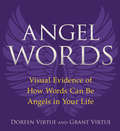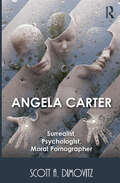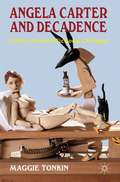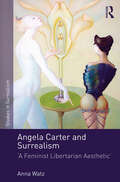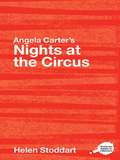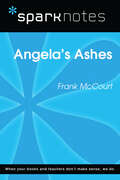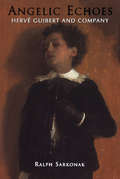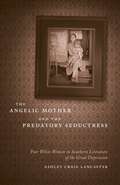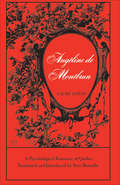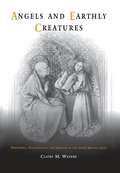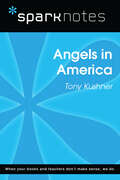- Table View
- List View
Andreas Vesalius and his Fabrica, 1537-1564: Changing the World of Anatomy (Palgrave Studies in Medieval and Early Modern Medicine)
by Vivian NuttonThis monograph presents a study of the most significant book in the history of anatomy, Fleming Andreas Vesalius’ (1514-1564) De humani corporis fabrica. Vesalius’ Fabrica was immediately recognised as changing the view of the human body when it was published in 1543, and it remains iconic today. Despite this, little has been written about Vesalius’ later revisions and corrections to the work, as well as his annotations leading up to the book. The author addresses this lacuna by examining the Fabrica from its inception in Paris in the 1530s, through its publication in 1543, to subsequent revisions and its present status as an expensive treasure. The book also contains new discoveries about the period of Vesalius’ earliest publications from 1537-8, the printing and production of the 1543 Fabrica, and the extensive remaking of the 1555 edition. Chapters also explore Vesalius’ background in new humanist medicine and anatomical teaching in Paris and Italy, the verbal message that the Fabrica was intended to convey, and the immediate responses to the book.
Andrew Jackson (SparkNotes Biography Guide)
by SparkNotesAndrew Jackson (SparkNotes Biography Guide) Making the reading experience fun! SparkNotes Biography Guides examine the lives of historical luminaries, from Alexander the Great to Virginia Woolf. Each biography guide includes: An examination of the historical context in which the person lived A summary of the person&’s life and achievements A glossary of important terms, people, and events An in-depth look at the key epochs in the person&’s career Study questions and essay topics A review test Suggestions for further reading Whether you&’re a student of history or just a student cramming for a history exam, SparkNotes Biography guides are a reliable, thorough, and readable resource.
Andrew Marvell: A Literary Life (Literary Lives)
by Matthew C. AugustineThis book provides an accessible account of the poet and politician Andrew Marvell’s life (1621-1678) and of the great events which found reflection in his work and in which he and his writings eventually played a part. At the same time, considerable space is afforded to reflecting deeply on the modes and meanings of Marvell’s art, redressing the balance of recent biography and criticism which has tended to dwell on the public and political aspects of this literary life at the expense of lyric invention and lyric possibility. Moving beyond the familiar terms of imitation and influence, the book aims at reconstructing an embodied history of reading and writing, acts undertaken within a series of complex physical and social environments, from the Hull Charterhouse to the coffee houses and print shops of Restoration London. Care has been taken to cover the whole of Marvell’s career, in verse and prose, even as the book places the lyric achievement at the centre of its vision.
Andrew Marvell: Loss and aspiration, home and homeland in Miscellaneous Poems
by A. D. CousinsThis monograph studies how, across the Folio of 1681, Marvell's poems engage not merely with different kinds of loss and aspiration, but with experiences of both that were, in mid-seventeenth-century England, disturbingly new and unfamiliar. It particularly examines Marvell's preoccupation with the search for home, and with redefining the homeland, in times of civil upheaval. In doing so it traces his progression from being a poet who plays sophisticatedly with received myth to being one who is a national mythmaker in rivalry with his poetic contemporaries such as Waller and Davenant. Although focusing primarily on poems in the Folio of 1681, this book considers those poems in relation to others from the Marvell canon, including the Latin poems and the satires from the reign of Charles II. It closely considers them as well in relation to verse by poets from the classical past and the European, especially English, present.
Andrew Marvell (Longman Critical Readers)
by Thomas HealyAndrew Marvell brings together ten recent and critically informed essays by leading scholars on one of the most challenging and important seventeenth-century poets. The essays examine Marvell's poems, from lyrics, such as 'To His Coy Mistress' and 'The Nymph Complaining for the Death of her Fawn', to celebrations of Cromwell and Republican Civil War culture and his biting Restoration satires. Representing the most significant critical trends in Marvell criticism over the last twenty years, the essays and the authoritative editorial work provide an excellent introduction to Marvell's work. Students of Renaissance and seventeenth-century literature, English Civil War writing, and seventeenth-century social and cultural history will find this collection a useful guide to helping them appreciate and understand Marvell's poetry.
Andrew Marvell: The Critical Heritage (The\critical Heritage Ser.)
by Andrew MarvellFirst published in 1986. Routledge is an imprint of Taylor & Francis, an informa company.
An Andrew Marvell Companion (Routledge Revivals #Vol. 1243)
by Robert H. RayFirst published in 1998, this title provides for the reader of the renowned metaphysical poet and politician a valuable reference and resource volume. It is a compendium of useful information for any reader of Andrew Marvell, including crucial biographical material, historical contextualisation, and details about his life’s work. The intention throughout is to enhance understanding and appreciation, without being exhaustive. The major portion of the volume, in both importance and size, is ‘A Marvell Dictionary’. Its entries are arranged alphabetically: they identify, describe and explain the most influential persons in Marvell’s life and works, as well as places, characters, allusions, ideas, concepts, individual words, phrases and literary terms that are relevant to a rounded appreciation of his poetry and prose. An Andrew Marvell Companion will prove invaluable for all students of English poetry and seventeenth-century political history.
Andrew's Mistake
by Kelly Kong April HartmannThe fun and excitement of English and Language Arts learning continues in Grade 2 of Reading Street. This comprehensive and dynamic curriculum for homeschooling is geared toward young children who have some foundational English and Language Arts knowledge and are ready to strengthen their skills. Comprised of engaging activities, challenging content and weekly quizzes, Reading Street: Grade 2 is the next step in your child's path toward becoming a lifelong learner and reader. As with all Reading Street products, the Grade 2 system is formatted to help students meet certain age-appropriate goals. After completing this English and Language Arts homeschool program, your child should be able to: Read and comprehend two-syllable words. Identify common prefixes (such as pre-, un-, or re-) and suffixes (such as -able, -ad and -er). Correct mistakes made when reading out loud. Read books with two or more chapters. Understand the structure of stores (i. e. beginning, middle and end). Start selecting reading materials based on his/her own interests. Identify the "who," "what," "when," "where," "why" and "how" of the text. While the goals of second Grade English and Language Arts are numerous, Reading Street will help you craft engrossing lessons. Your child will garner important English and Language Arts skills while completing a workbook, reading stories and poems, and taking assessments. Planning these lessons will be easier than ever, as all Reading Street systems are broken down into weekly Big Ideas. All the work your child does on a given week is formulated around that single concept for an organized and challenging curriculum. With six easy-to-follow units, Reading Street: Grade 2 is the perfect tool for homeschooling parents. Your child will enjoy the reading selections and activities, and you'll love to see your student growing into a knowledgeable individual. We're confident that this product is the right one for you. For more information on the specific materials found in Grade 2 of Reading Street, check out the Features and Benefits page.
Androids and Intelligent Networks in Early Modern Literature and Culture: Artificial Slaves (Routledge Studies in Renaissance Literature and Culture)
by Kevin LaGrandeurAwarded a 2014 Science Fiction and Technoculture Studies Prize Honourable Mention. This book explores the creation and use of artificially made humanoid servants and servant networks by fictional and non-fictional scientists of the early modern period. Beginning with an investigation of the roots of artificial servants, humanoids, and automata from earlier times, LaGrandeur traces how these literary representations coincide with a surging interest in automata and experimentation, and how they blend with the magical science that preceded the empirical era. In the instances that this book considers, the idea of the artificial factotum is connected with an emotional paradox: the joy of self-enhancement is counterpoised with the anxiety of self-displacement that comes with distribution of agency.In this way, the older accounts of creating artificial slaves are accounts of modernity in the making—a modernity characterized by the project of extending the self and its powers, in which the vision of the extended self is fundamentally inseparable from the vision of an attenuated self. This book discusses the idea that fictional, artificial servants embody at once the ambitions of the scientific wizards who make them and society’s perception of the dangers of those ambitions, and represent the cultural fears triggered by independent, experimental thinkers—the type of thinkers from whom our modern cyberneticists descend.
Andy Warhol, Publisher
by Lucy MulroneyAlthough we know him best as a visual artist and filmmaker, Andy Warhol was also a publisher. Distributing his own books and magazines, as well as contributing to those of others, Warhol found publishing to be one of his greatest pleasures, largely because of its cooperative and social nature. Journeying from the 1950s, when Warhol was starting to make his way through the New York advertising world, through the height of his career in the 1960s, to the last years of his life in the 1980s, Andy Warhol, Publisher unearths fresh archival material that reveals Warhol’s publications as complex projects involving a tantalizing cast of collaborators, shifting technologies, and a wide array of fervent readers. Lucy Mulroney shows that whether Warhol was creating children’s books, his infamous “boy book” for gay readers, writing works for established houses like Grove Press and Random House, helping found Interview magazine, or compiling a compendium of photography that he worked on to his death, he readily used the elements of publishing to further and disseminate his art. Warhol not only highlighted the impressive variety in our printed culture but also demonstrated how publishing can cement an artistic legacy.
The Angel and the Perverts (The Cutting Edge: Lesbian Life and Literature Series #9)
by Lucie Delarue-MardrusSet in the lesbian and gay circles of Paris in the 1920s, The Angel and the Perverts tells the story of a hermaphrodite born to upper class parents in Normandy and ignorant of his/her physical difference. As an adult, s/he lives a double life as Marion/Mario, passing undetected as a lesbian in the literary salons of the times, and as a gay man in the cocaine dens made famous by Colette. Delarue-Mardrus's novel belongs to a category of literature, written between the turn of the century and approximately 1930, which depicted lesbians as members of a third sex. The hermaphrodite became the visual representation of the ways in which lesbians were different from their heterosexual sisters, and Rene Vivien, Natalie Clifford Barney, Rachilde, and Colette, among others, shared Delarue-Mardrus's fascination with the topic.This is the first translation into English of The Angel and the Perverts. In an astute introduction, Anna Livia rereads Lucie Delarue-Mardrus as a prolific and significant writer, despite the fact that previous scholars viewed her primarily as the wife of the scholar and translator Joseph-Charles Mardrus. Livia also places Delarue-Mardrus's life in a lesbian context for the first time and decodes this delightful novel so that readers will feel quite at home in Mario/Marion's unusual world, which runs the gamut from Auguste Rodin to Jean Cocteau and Sarah Bernhardt.
The Angel out of the House: Philanthropy and Gender in Nineteenth-Century England (Victorian Literature and Culture Series)
by Dorice Williams ElliottWas nineteenth-century British philanthropy the "truest and noblest woman's work" and praiseworthy for having raised the nation's moral tone, or was it a dangerous mission likely to cause the defeminization of its practitioners as they became "public persons"? In Victorian England, women's participation in volunteer work seemed to be a natural extension of their domestic role, but like many other assumptions about gender roles, the connection between charitable and domestic work is the result of specific historical factors and cultural representations. Proponents of women as charitable workers encouraged philanthropy as being ideal work for a woman, while opponents feared the practice was destined to lead to overly ambitious and manly behavior.In The Angel out of the House Dorice Williams Elliott examines the ways in which novels and other texts that portrayed women performing charitable acts helped to make the inclusion of philanthropic work in the domestic sphere seem natural and obvious. And although many scholars have dismissed women's volunteer endeavors as merely patriarchal collusion, Elliott argues that the conjunction of novelistic and philanthropic discourse in the works of women writers--among them George Eliot and Elizabeth Gaskell, Hannah More and Anna Jameson--was crucial to the redefinition of gender roles and class relations.In a fascinating study of how literary works contribute to cultural and historical change, Elliott's exploration of philanthropic discourse in nineteenth-century literature demonstrates just how essential that forum was in changing accepted definitions of women and social relations.
Angel Words: Visual Evidence Of How Words Can Be Angels In Your Life
by Doreen Virtue Grant VirtueWhen Doreen and her son Grant Virtue were recording podcasts, they noticed that whenever she said the word angel, the recording graphics were shaped like angel wings! So they studied the other words she said and realized that those with a spiritual or loving basis had large graphs. So they experimented with saying negative words and found that their appearance was completely different: tight and small. Similar to Masaru Emoto's work with water crystals, Angel Words gives visual proof of the power and impact of speaking in a loving way. You'll come to understand why positive words express the most energy and therefore have the most power to manifest your dreams. You'll also see how negative words have low energy and read how they can actually draw negative experiences to you. This unforgettable book will immediately motivate you to choose positive words!
Angela Carter: Surrealist, Psychologist, Moral Pornographer
by Scott DimovitzContributing to the conversation regarding Angela Carter's problematic relationship with what she viewed as the interrelated traditions of surrealism and psychoanalysis, Scott Dimovitz explores the intricate connections between Carter's private life and her public writing. He begins with Carter's assertion that it was through her "sexual and emotional life" that she was radicalized, drawing extensively on the British Library's recently archived collection of Carter's private papers, journals, and letters to show how that radicalization happened and what it meant both for her worldview and for her writings. Through close textual analysis and a detailed study of her papers, Dimovitz analyzes the ways in which this second-wave feminist's explorations of sexuality merged with her investigations into surrealism and psychoanalysis, an engagement that ultimately led to the explosively surreal allegories of Carter's later, more complex, and more accomplished work. His study not only offers a new way to view Carter's oeuvre, but also makes the case for the importance of Angela Carter's vision in understanding the transformations in feminist thinking from the postwar to the postfeminist generation.
Angela Carter and Decadence
by Maggie TonkinBy reading key Carter texts alongside their Decadent intertexts, Tonkin interrogates the claim that Carter was in thrall to a fetishistic aesthetic antithetical to her feminism. Through historical contextualization of the woman-as-doll, muse and femme fatale, Tonkin tests Carter's own description of her fiction as a form of literary criticism.
Angela Carter and Surrealism: 'A Feminist Libertarian Aesthetic' (Studies in Surrealism)
by Anna WatzIn 1972, Angela Carter translated Xavière Gauthier’s ground-breaking feminist critique of the surrealist movement, Surréalisme et sexualité (1971). Although the translation was never published, the project at once confirmed and consolidated Carter’s previous interest in surrealism, representation, gender and desire and aided her formulation of a new surrealist-feminist aesthetic. Carter’s sustained engagement with surrealist aesthetics and politics as well as surrealist scholarship aptly demonstrates what is at stake for feminism at the intersection of avant-garde aesthetics and the representation of women and female desire. Drawing on previously unexplored archival material, such as typescripts, journals, and letters, Anna Watz’s study is the first to trace the full extent to which Carter’s writing was influenced by the surrealist movement and its critical heritage. Watz’s book is an important contribution to scholarship on Angela Carter as well as to contemporary feminist debates on surrealism, and will appeal to scholars across the fields of contemporary British fiction, feminism, and literary and visual surrealism.
Angela Carter's Nights at the Circus: A Routledge Study Guide (Routledge Guides to Literature)
by Helen StoddartA highly original and influential work of modern British literature, Angela Carter’s Nights at the Circus combines a fantastically creative plot with a strong political undertone. The result is an emotive and provocative novel, which has attracted much critical attention from a range of perspectives including poststructuralism, gender studies, postmodernism and psychoanalysis. This guide to Angela Carter’s complex novel, presents: an accessible introduction to the text and contexts of Nights at the Circus a critical history, surveying the many interpretations of the text from publication to the present a selection of new critical essays on the Nights at the Circus, by Heather Johnson, Jeannette Baxter, Sarah Sceats and Helen Stoddart, providing a variety of perspectives on the novel and extending the coverage of key critical approaches identified in the survey section cross-references between sections of the guide, in order to suggest links between texts, contexts and criticism suggestions for further reading. Part of the Routledge Guides to Literature series, this volume is essential reading for all those beginning detailed study of Nights at the Circus and seeking not only a guide to the novel, but a way through the wealth of contextual and critical material that surrounds Carter’s text.
Angela's Ashes (SparkNotes Literature Guide Series)
by SparkNotesAngela's Ashes (SparkNotes Literature Guide) by Frank McCourt Making the reading experience fun! Created by Harvard students for students everywhere, SparkNotes is a new breed of study guide: smarter, better, faster. Geared to what today's students need to know, SparkNotes provides: chapter-by-chapter analysis explanations of key themes, motifs, and symbols a review quiz and essay topics Lively and accessible, these guides are perfect for late-night studying and writing papers.
Angelic Echoes: Hervé Guibert and Company
by Ralph SarkonakIn 1990 Hervé Guibert gained wide recognition and notoriety with the publication of "À l'ami qui ne m'a pas sauvé la vie (To the Friend Who Did Not Save My Life)". This novel, one of the most famous AIDS fictions in French or any language, recounts the battle of the first-person narrator not only with AIDS but also with the medical establishment on both sides of the Atlantic. Photography critic for Le Monde from 1977-1985, Guibert was also the co-author (with Patrice Chéreau) of a film script, L'Homme Blessé, which won a César in 1984, and author of more than twenty-five books, eight of which have been translated into English. In this vibrant and unusual study, Ralph Sarkonak examines many intriguing aspects of Guibert's life and production: the connection between his books and his photography, his complex relationship with Roland Barthes and with his friend and mentor Michel Foucault (relationships that were at once literary, intellectual, and personal in each case); the ties between his writing and that of his contemporaries, including Renaud Camus, France's most prolific gay writer; and his development of an AIDS aesthetic. Using close textual analysis, Sarkonak tracks the convolutions of Guibert's particular form of life-writing, in which fact and fiction are woven into a corpus that evolves from and revolves around his preoccupations, obsessions, and relationships, including his problematic relationship with his own body, both before and after his HIV-positive diagnosis. Guibert's work is a brilliant example of the emphasis on disclosure that marks recent queer writing – in contrast to the denial and cryptic allusion that characterized much of the work by gay writers of previous generations. Yet, as Sarkonak concludes, Guibert treats the notions of falsehood and truth with a postmodern hand: as overlapping constructs rather than mutually exclusive ones – or, to use Foucault's expression, as "games with truth."
The Angelic Mother and the Predatory Seductress: Poor White Women in Southern Literature of the Great Depression (Southern Literary Studies)
by Ashley Craig LancasterIn The Angelic Mother and the Predatory Seductress, Ashley Craig Lancaster examines how converging political and cultural movements helped to create dualistic images of southern poor white female characters in Depression-era literature. While other studies address the familial and labor issues that challenged female literary characters during the 1930s, Lancaster focuses on how the evolving eugenics movement reinforced the dichotomy of altruistic maternal figures and destructive sexual deviants. According to Lancaster, these binary stereotypes became a new analogy for hope and despair in America's future and were well utilized by Depression-era politicians and authors to stabilize the country's economic decline. As a result, the complexity of women's lives was often overlooked in favor of stock characters incapable of individuality. Lancaster studies a variety of works, including those by male authors William Faulkner, Erskine Caldwell, and John Steinbeck, as well as female novelists Mary Heaton Vorse, Myra Page, Grace Lumpkin, and Olive Tilford Dargan. She identifies female stereotypes in classics such as To Kill a Mockingbird and in the work of later writers Dorothy Allison and Rick Bragg, who embrace and share in a poor white background.The Angelic Mother and the Predatory Seductress reveals that these literary stereotypes continue to influence not only society's perception of poor white southern women but also women's perception of themselves.
Angéline de Montbrun: A Psychological Romance of Quebec
by Laure Conan Yves BrunelleLaure Conan was the first woman novelist in French Canada and the first writer in all Canada to attempt a roman d'analyse. As she refused to have her true identity revealed, the author of the preface to her book, Abbé H.-R. Casgrain, made a point of confirming that it was indeed a woman hiding behind the pen-name. Her daring in writing a psychological novel was 'forgiven' because she was a woman, and her anticipating the trend towards this type of novel was attributed to 'that intuition natural to her sex.' In Angéline de Montbrun, Laure Conan broke with what has been called the 'collective romanticism' of nineteenth-century French-Canadian land, with the rural myth, the exhortative tone, and the vast canvas. These concerns are basically absent in her work. Further, she eschewed the details of adventure and intrigue, the wooden, predictable characters, and the transparent intricacies of romantic love in favour of writing about the inner turmoil of an individual, live character, a young woman caught in a complex web of human appetites, aspirations, and relationships. Because of the novel's realism, one of the most persistent topics of discussion about Laure Conan has been whether or not Angéline de Montbrun is autobiographical. Recent studies indicate it may be. In any case, Angéline was the most complex character in Canadian fiction to 1882 and for some time to come. Traditionally, Angéline de Montbrun was regarded as a novel of Christian renunciation, and Angéline as the most holy of heroines. For a long time no one went too deeply into the relationships between the characters, but in 1961 Jean Le Moyne bluntly stated that 'the lovers in the novel are not Maurice Darville and Angéline, but M. de Montbrun and his daughter.' Since then there has been a proliferation of interpretations and psychological studies of the novel, and there is no going back to the simpler view of it.
Angels and Earthly Creatures: Preaching, Performance, and Gender in the Later Middle Ages (The Middle Ages Series)
by Claire M. WatersTexts by, for, and about preachers from the twelfth to the fourteenth centuries reveal an intense interest in the preacher's human nature and its intersection with his "angelic" role. Far from simply denigrating embodiment or excluding it from consideration, these works recognize its centrality to the office of preacher and the ways in which preachers, like Christ, needed humanness to make their performance of doctrine effective for their audiences. At the same time, the texts warned of the preacher's susceptibility to the fleshly failings of lust, vainglory, deception, and greed. Preaching's problematic juxtaposition of the earthly and the spiritual made images of women preachers, real and fictional, key to understanding and exploiting the power, as well as the dangers, of the feminized flesh.Addressing the underexamined bodies of the clergy in light of both medieval and modern discussions of female authority and the body of Christ in medieval culture, Angels and Earthly Creatures reinserts women into the history of preaching and brings together discourses that would have been intertwined in the Middle Ages but are often treated separately by scholars. The examination of handbooks for preachers as literary texts also demonstrates their extensive interaction with secular literary traditions, explored here with particular reference to Chaucer's Canterbury Tales.Through a close and insightful reading of a wide variety of texts and figures, including Hildegard of Bingen, Birgitta of Sweden, and Catherine of Siena, Waters offers an original examination of the preacher's unique role as an intermediary—standing between heaven and earth, between God and people, participating in and responsible to both sides of that divide.
Angels in America (SparkNotes Literature Guide Series)
by SparkNotesAngels in America (SparkNotes Literature Guide) by Tony Kushner Making the reading experience fun! Created by Harvard students for students everywhere, SparkNotes is a new breed of study guide: smarter, better, faster.Geared to what today's students need to know, SparkNotes provides:*chapter-by-chapter analysis *explanations of key themes, motifs, and symbols *a review quiz and essay topics Lively and accessible, these guides are perfect for late-night studying and writing papers.
